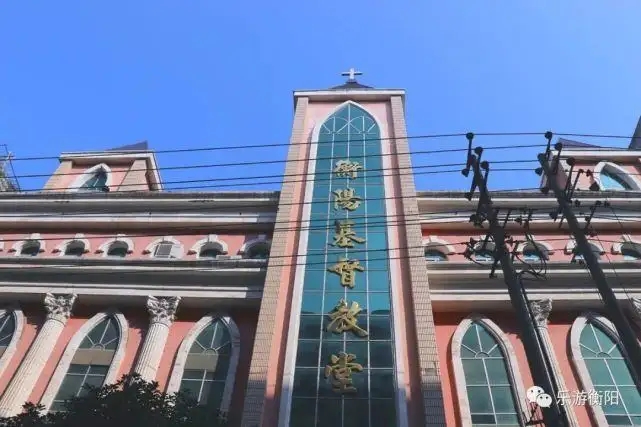| Religion in Hengyang |
| From:衡阳市党政门户网 | Date Add in:2022-03-29 13:35:29 [A A] |
|
Hengyang is a place where religions have long intermingled. After a long time of conflicts between Buddhism, Taoism, and Confucianism, they have blended together harmoniously. As one of 1. Buddhism Buddhism has been brought intoHengyangsince 502 A. D. in Liang Dynasty, and it has been well preserved and developed in Mount. Heng. Monk Huihai and Xixun came into the Mount. Heng. They made efforts to buildFangguangTemplefor preaching Buddhism. Then another great monk Huisi was also attracted by this sacred mountain. The emperor even ordered his officers to dominate money for building temples, including the Top Ten Temples, such asNantaiTempleandJingdeTemple, in Mount. Heng. There were several hundreds monks living in those temples. During Tang Dynasty (618-907A.D.), some important sects in Buddhism had been found such as Faxiang, Tiantai, Huaiyan and Zen. Mount. Heng thus became one of the birthplaces of Zen. Zen represents the most influential and widespread sect of Nanyue Buddhism which emphasizes “sudden insight” and the so-called “Buddha residing in your heart”. It recommends a flexible attitude toward the secular world. In the beginning of 12th century, a Japanese monk Daoyuan came into
2. Taoism Taoism, as an important constitution of Nan Yue religious culture, has exerted far-reaching influence on spreading and shaping Nan Yue culture during its time-honored history of development. Taoism, with a long history, was brought into Nan Yue 200 years earlier than Buddhism. During Han Dynasty (156-87 B. C.), many pioneering Taoists such as Maoying and Wang Gushen cultivated themselves according to Taoism in Mount. Heng. Even the Emperor Wu conferred titles on those great Taoists. At the beginning of Jin Dynasty (265-310 A. D.), taking Moral Intelligence as the doctrine, many famous Taoists such as Shi Cun and Wei Huacun cultivated themselves in Mount. Heng. They built Guan (Taoist temple), recruited Taoist priests, and preached Taoism. Since then, many Guans had been built in different dynasties. Among them, the famous Jiuzhen Guan (Taoist temple) was built in 280 A.D., and Xunzhen Guan (Taoist temple) was built inHengyangcity in Tang Dynasty (618-907 A.D.). There were many sects in Taoism. Generally speaking, Taoism can be mainly divided into two groups. One is Quanzhen Sect in the north; the other Zhengyi in the south. Quanzhen Sect was created by Wang Chongyang in Jin Dynasty (1115-1234 A. D.). He advocated that Taoists should cultivate themselves through Taoism disciplines. Therefore, Taoists of Quanzhen Sect could not marry, drink or eat meat. Quanzhen Sect attracted many believers. Nowadays, there are still 98 Taoists of Quanzhen Sect. Zhengyi Sect adores gods for driving evil. The Taoists of Zhengyi Sect could marry and eat meat except the days for abstinence. The Baxian Guan (Taoist temple), Chaoyang Guan (Taoist temple) and Yuntai Guan (Taoist temple) inHengnanCountyare for Zhengyi Sect. However, many Guans (Taoist temples) were ruined in wars, and believers gradually gave up their belief in Zhengyi Sect after the movement of abolishing superstition. Today there are about 200 believers. As recorded inNanYue Chronicle in Qing Dynasty (1636-1011 A. D.), there were 45 Guans (Taoist temples) and Gongs (Taoist palaces) with 109 Taoists. Some of the Taoists built temples, some cultivated themselves in Taoism, some roamed in the mountain, and some talked about metaphysics and preached Tao (the origin of the universe), or even established their own theory and wrote Taoism scriptures. The advent of Lord Laozi in theMountHengcould be traced back to the pre-Qin period (before 221 B. C.). In the Western Han Dynasty (212 B. C.-9 A. D.), Taoist Mao Ying visited Taoist masters. In the Eastern Han Dynasty (25-220 A. D.), the Heavenly Master Hang Daolin held ceremony inZhuRongJunAncestralTemple. In Jin Dynasty (265-420 A. D.), Wei Yuanjun founded "Shangqing Sect" and was respected as Da Zong (the origin of the universe). In Tang Dynasty (618-907 A. D.), Cengzhen proofread Moral Intelligence (the most important canon of Taoism) and discussed Tao with the emperor. In Song Dynasty (960-1279 A. D.), Cheng Tianfu explored in the deep mountain to search for spectacular scenery and wrote the book Scenery Spots in Nanyue. In the Yuan and Ming Dynasty, Zhang Sanfeng made elixir at the back of the Nine-immortal Guan (Taoist temple). In Ming and Qing Dynasty (1368-1644 A. D.), Li Changgeng built the Flying Guan (Taoist temple) in front of the Nine-immortal Guan (Taoist temple). In 1992, Nan Yue Taoist Association was found, making great contribution to rebuild Guans (Taoist temples) such as Xuandu Guan (Taoist temple), Huangting Guan (Taoist temple). It also organizes many activities such as Taoist concert. The Association keeps friendly contact with the Taoists in
3. Christianity Christianity was brought intoHengyangwith the Opium War in 1840. The Christian church of Hengyang, located onSouth Zhongshan Road, was originally built in 1902 as a Chinese Presbyterian Church.
|
Co-sponsored by Information Office of Hengyang Municipal People's Government Technical Support & Design:Hengyang Normal University
ICP NO:05002289

